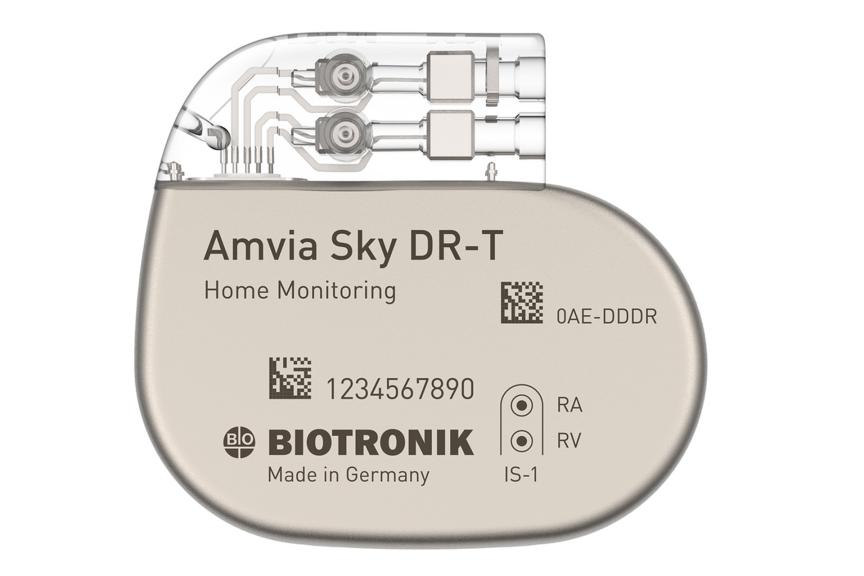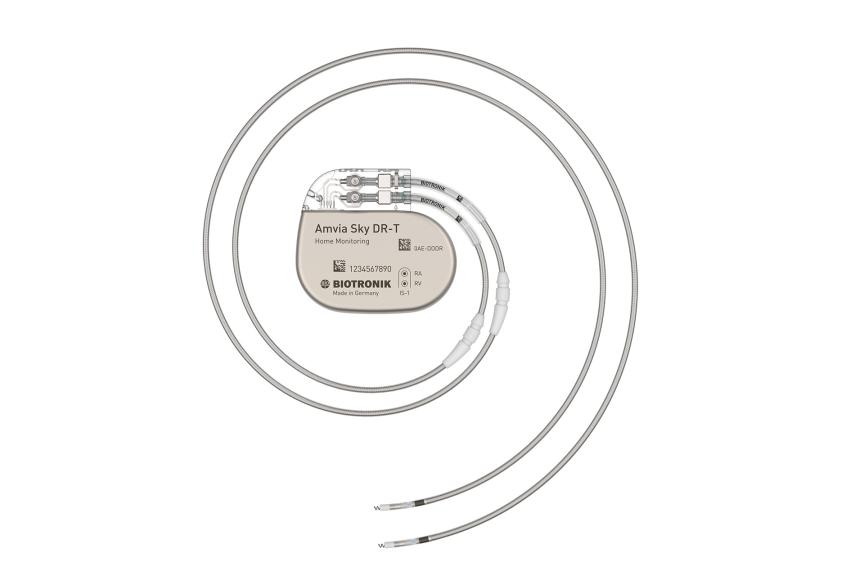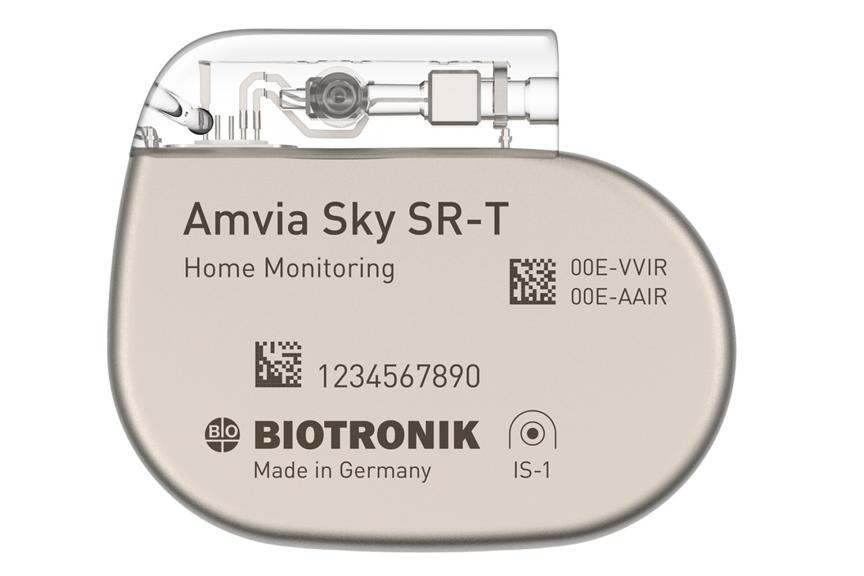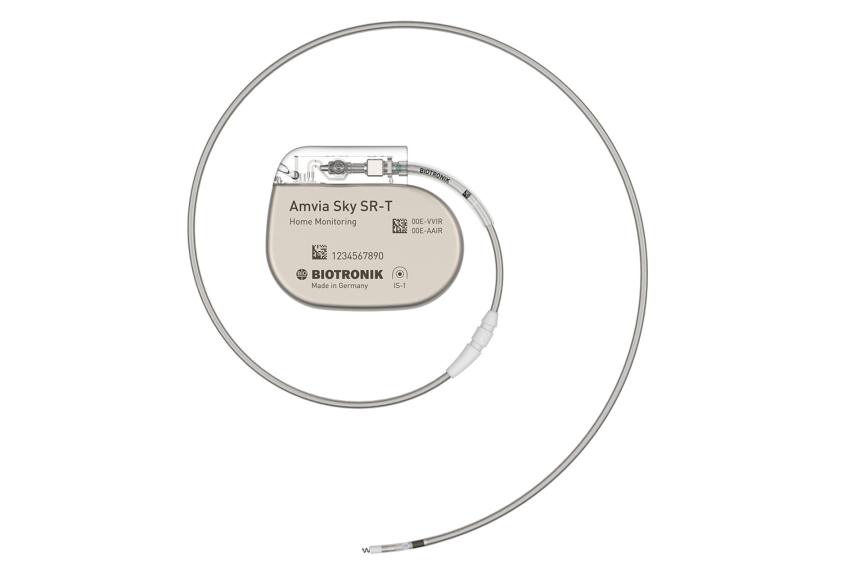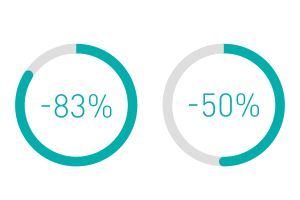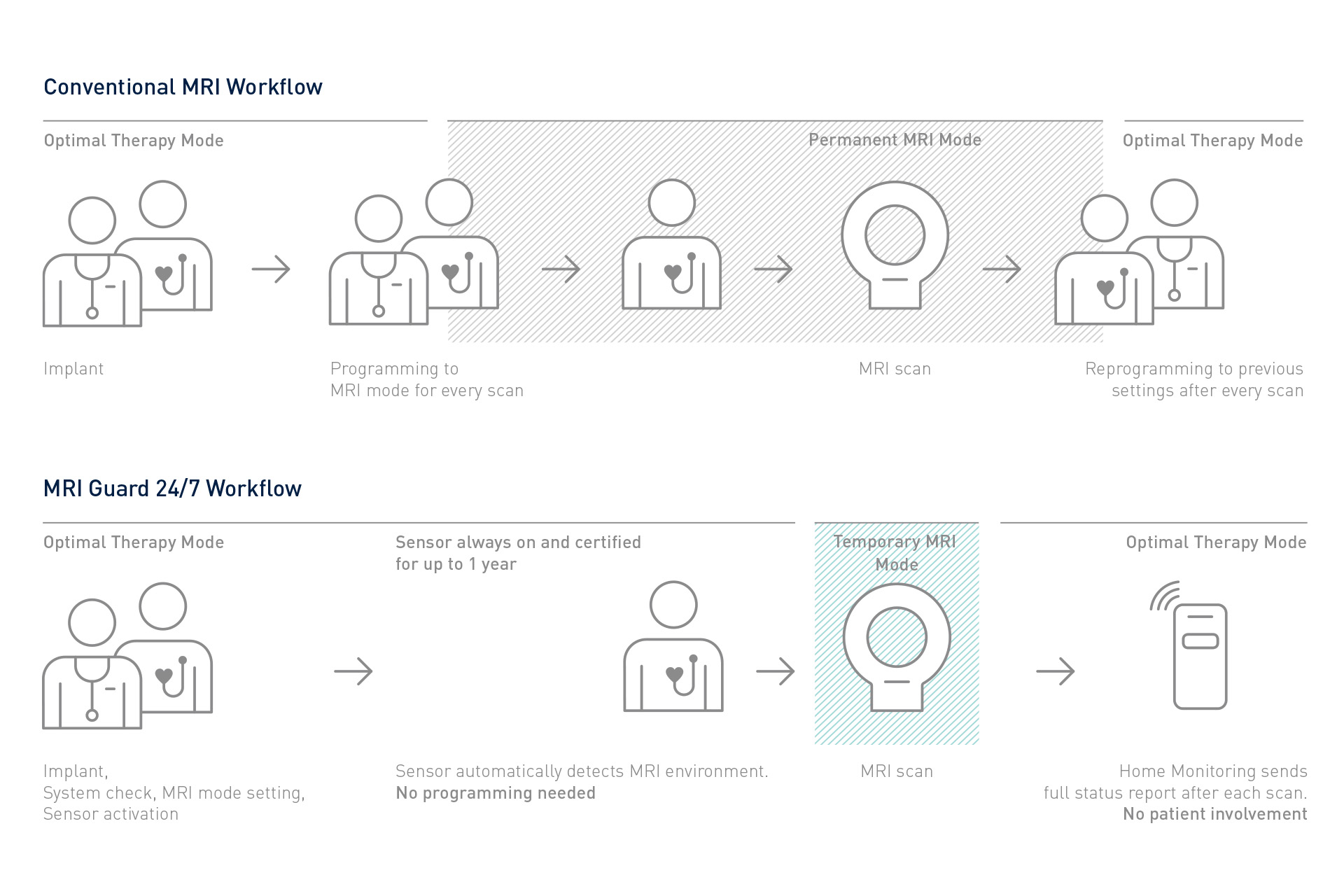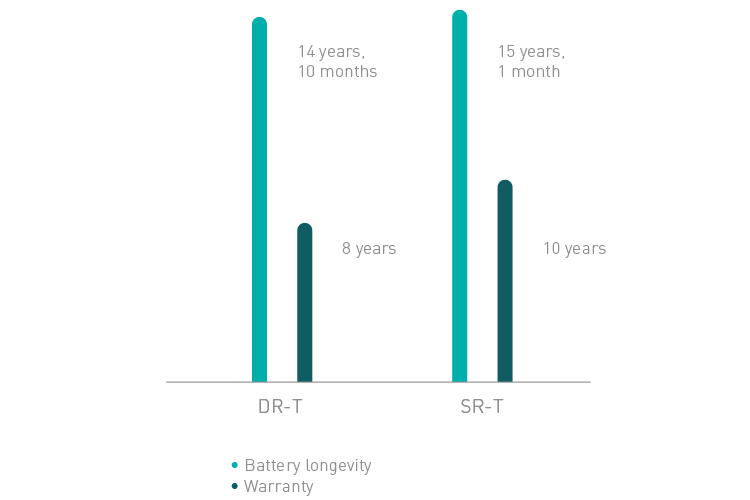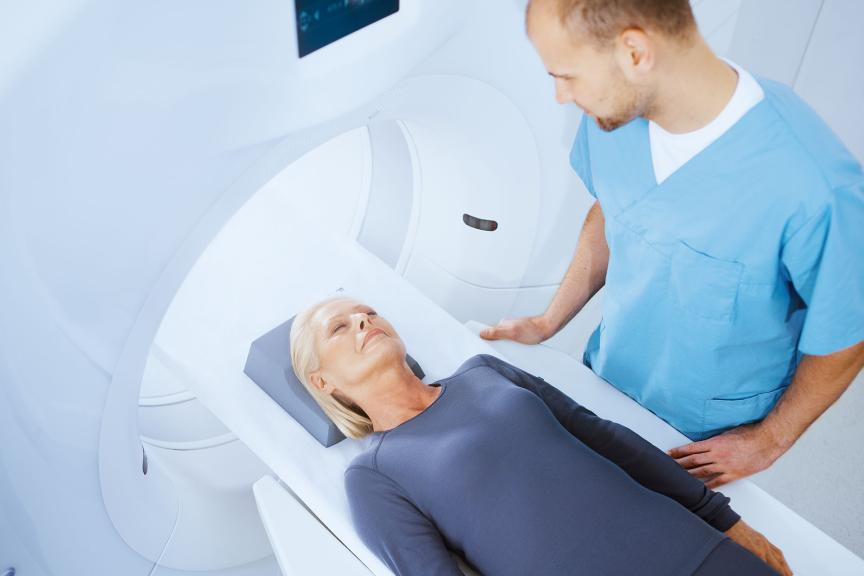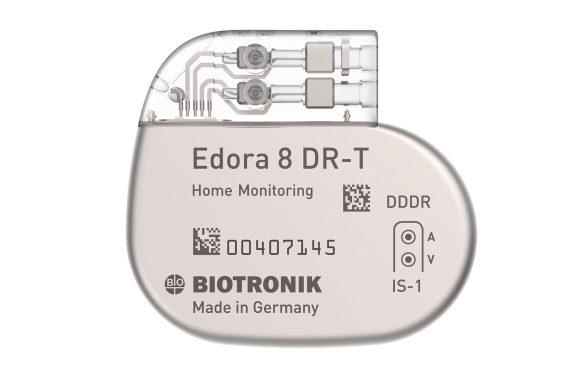Amvia Sky DR-T/SR-T
Amvia Sky ermöglicht ein einfaches elektronisches Entlassmanagement und dank Home Monitoring ein engmaschiges Patientenmonitoring. Neue Funktionen können Arbeitsabläufe vereinfachen und Wartezeiten verkürzen..
- EarlyCheck ermöglicht eine erste Home-Monitoring-gestützte Nachsorge vor der Entlassung.
- Die Funktion QuickCheck ermöglicht einen schnellen Zugriff auf Patientendaten in der Nachsorge. Bei einer ärztlichen Abfrage sind Daten aus dem BIOTRONIK Home Monitoring in der Regel innerhalb weniger Minuten verfügbar.
- Die Option, bis zu 25 IEGM Episoden aufzuzeichnen, bietet bessere diagnostische Möglichkeiten.
Als erster Herzschrittmacher verfügt Amvia über eine Zulassung für die Stimulation in der Linksschenkel-Region (LBBAP)1. Ausserdem bietet diese Schrittmacher-Plattform ein breites Spektrum an Behandlungsoptionen, darunter physiologische Stimulation und Funktionen zur Vermeidung von Vorhofflimmern (AF). Viele Routineaufgaben bei Implantation, Präsenznachsorgen, Fernüberwachung und MRT-Scans sind automatisiert. So können Sie einer grösseren Zahl Ihrer Patienten mehr persönliche Aufmerksamkeit widmen können.
In Verbindung mit der PatientApp wird eine aktive Interaktion zwischen Ihnen und ihren Patienten ermöglicht. Diese erhalten Informationen zu Datenübertragung, Batterie- und Aggregatstatus.
Produkt-Highlights
Physiologische Stimulation
Amvia Sky ist der erste Herzschrittmacher, der für die Stimulation in der Linksschenkel-Region (LBBAP) zugelassen ist.1 Die einzigartige Sensortechnologie Closed-Loop-Stimulation (CLS) des Amvia Sky folgt dem vegetativen Nervensystem und sorgt automatisch2 für eine Anpassung an die natürliche intrinsische Regulation der Herzleistung.3
Management atrialer Arrhythmien
Amvia Sky hilft Patienten, über lange Zeiträume hinweg physiologische Herzfrequenzen aufrechtzuerhalten. Er kombiniert Monitoring-Funktionen in Präsenz- und Fernüberwachungsszenarios mit den Arrhythmiemanagement-Tools von Atrial ATP (aATP), um der Entwicklung von Vorhofflimmern möglichst früh entgegenzusteuern.14
Vereinfachung der Versorgungspfade
Amvia Sky bietet mehrere Lösungen zur Vereinfachung der Arbeitsabläufe von der Implantation und Nachsorge bis hin zur Fernüberwachung und herausragendem MRT-Zugang.
Downloads und weitere Links
Kontaktieren Sie uns
Referenzen
1) Gebrauchsanweisung zu Amvia Sky von BIOTRONIK; Handbuch zu Azure XT DR MRI SureScan™ von Medtronic; Gebrauchsanweisung zu Accolade MRI™ von Boston Scientific; Benutzerhandbuch zu Assurity MRI™ von Abbott; Implantathandbuch zu Alizea™ von MicroPort. 2) Lindovska M., Kameník L., Pollock B., et al. Clinical observations with Closed Loop Stimulation pacemakers in a large patient cohort: the CYLOS routine documentation registry (RECORD). Europace. 2012; 14: 1587–1595. 3) Santini M., Ricci R., Pignalberi C., et al. Effect of autonomic stressors on rate control in pacemakers using ventricular impedance signal. Pacing Clin Electrophysiol. 2004; 27: 24-32. 4) Sharma PS., Patel NR., Ravi V., et al. Clinical outcomes of left bundle branch area pacing compared to right ventricular pacing: Results from the Geisinger-Rush Conduction System Pacing Registry. Heart Rhythm. 2022; 19(1): 3-11. 5) De Pooter J., Ozpak E., Calle S., et al. Initial experience of left bundle branch area pacing using stylet-driven pacing leads: A multicenter study. J Cardiovasc Electrophysiol. 2022; 33(7): 1540-1549. Haftungsausschluss: Dieses Material enthält lediglich eine Zusammenfassung über den Einsatz von Tools zur Stimulation des Reizleitungssystems (Conduction System Pacing, CSP) zu Forschungszwecken von De Pooter et al. Bitte beachten Sie, dass die Solia S-Elektrode nicht für die CSP zugelassen ist. Die CSP-Produkte von BIOTRONIK sind in den Vereinigten Staaten derzeit nicht für die Stimulation des Reizleitungssystems zugelassen. Der Inhalt dieses Dokuments ist nicht für Gesundheitsdienstleister in den Vereinigten Staaten bestimmt. 6) Menezes AS., Daher MT., Nascente CM., Moreira HG., Moreira TAC., and Campos RN. Correlation among Closed Loop Stimulation, cardiopulmonary capacity, and quality of life PBMR. 2003; 8(2): 119-124. 7) Pavri BB and Russel S. An impedance sensor is superior to an accelerometer for chronotropically incompetent patients with sinus node dysfunction: results of a pilot study with a dual sensor pacemaker. Circulation. 2006; 114: II_749. 8) Coenen M., Malinowski K., Spitzer W., et al. Closed Loop Stimulation and accelerometer based rate adaptation: results of the PROVIDE study, Europace. 2008; 10: 327-333. 9) Malinowski K. Interindividual comparison of different sensor principles for rate adaptive pacing PACE. 1998; 21(PT II): 2209-2213. 10) Abi-Samra FM., Singh N., Rosin BL., Dwyer JV., and Miller C. Europace. 2013; 15: 849-856. 11) Puglisi A., Favale S., Scipione P., et al. Overdrive versus conventional closed-loop rate modulation pacing in the prevention of atrial tachyarrhythmias in brady-tachy syndrome: on behalf of the Burden II study group. Pacing Clin Electrophysiol. 2008; 11: 1443-55. 12) Ikeda S., Nogami A., Inoue K., et al. Closed‐loop stimulation as a physiological rate‐modulated pacing approach based on intracardiac impedance to lower the atrial tachyarrhythmia burden in patients with sinus node dysfunction and atrial fibrillation. J Cardiovasc Electrophysiol. 2020; 31: 1187-1194. 13) Coenen M., Malinowski K., Spitz W., et al. Closed loop stimulation and accelerometer-based rate adaptation: results of the PROVIDE study. Europace. 2008; 10: 327-333. 14) Mabo P., Victor F., Bazin P., et al. A randomized trial of long-term remote monitoring of pacemaker recipients (the COMPAS trial). Eur Heart J. 2012; 33(9): 1105-1111. 15) Nattel S., Burstein B., Dobrev D. Atrial remodeling and atrial fibrillation: mechanisms and implications. Circ Arrhythm Electrophysiol. 2008; 1(1): 62-73. 16) Daten liegen vor. 17) Varma N., Epstein AE., Irimpen A., et al. Efficacy and safety of automatic remote monitoring for implantable cardioverter-defibrillator follow-up: the Lumos-T Safely Reduces Routine Office Device Follow-up (TRUST) trial. Circulation. 2010; 122(4): 325-332. 18) Mullane S., Michaelis K., Henrickson C., et al. Utilization and programming of an automatic MRI recognition feature for cardiac rhythm management devices. Heart Rhythm O2. 2021; 2: 132–137. 19). Daten liegen vor. 20) Siddamsetti S., Shinn A., Gautam S. Remote programming of cardiac implantable electronic devices: a novel approach to program cardiac devices for magnetic resonance imaging. J Cardiovasc Electrophysiol. 2022;33(5):1005–1009. 21) Watanabe E., Yamazaki F., Goto T., et al. Remote management of pacemaker patients with biennial in-clinic evaluation: continuous Home Monitoring in the Japanese At-Home study: A randomized clinical trial. Circ Arrhythm Electrophysiol. 2020 May;13(5):e007734. doi: 10.1161/CIRCEP.119.007734. 22) Ricci RP., Morichelli L., Quarta L., et al. Long-term patient acceptance of and satisfaction with implanted device remote monitoring, Europace. 2010; 12(5): 674-679. 23) Garcia-Fernández FJ., Asensi JO., Romero R., et al. Safety and efficiency of a common and simplified protocol for pacemaker and defibrillator surveillance based on remote monitoring only: a long-term randomized trial (RM-ALONE). Eur Heart J. 2019; 40(23): 1837–1846. 24) Daten liegen vor. 25) Daten liegen vor. 26) Amvia Sky SR-T 10 Jahre; Beschränkte Garantie für elektronische Herzrhythmusimplantate von BIOTRONIK; Zusammenfassung der beschränkten Garantie von Medtronic; Informationen und Formulare zur beschränkten Garantie von Boston Scientific; Referenzhandbuch für Garantieverfahren von Abbott CRM-Implantaten; Handbuch für Alizea DR™/Alizea SR™-Implantate von Microport. 27) Amvia Sky DR-T 8 Jahre; Beschränkte Garantie für elektronische Herzrhythmusimplantate von BIOTRONIK; Zusammenfassung der beschränkten Garantie von Medtronic; Informationen und Formulare zur beschränkten Garantie von Boston Scientific; Referenzhandbuch für Garantieverfahren von Abbott CRM-Implantaten; Handbuch für Alizea DR™/Alizea SR™-Implantate von Microport. 28) Amvia Sky SR-T: Bei 2,5 V/0,4 ms, 60 bpm, 500 Ω; Stimulation: 50 %, Home Monitoring: AUS, QuickCheck: AUS, RF-Telemetrie: AUS. 29) Amvia Sky DR-T: A: 2,5 V/0,4 ms, 60 bpm, 500 Ω, Stimulation: 50 %, RV: 2,5 V/0,4 ms, 60 bpm, 500 Ω, Stimulation: 5 %, Home Monitoring: AUS, QuickCheck: AUS, RF-Telemetrie: AUS, Vp Suppression: EIN.

